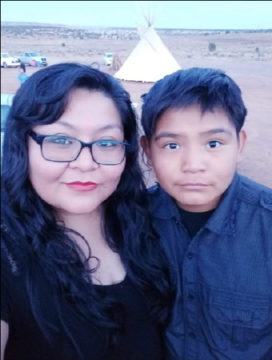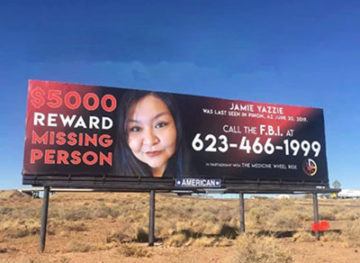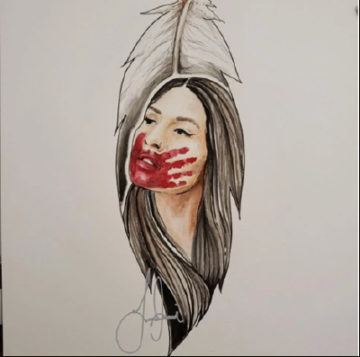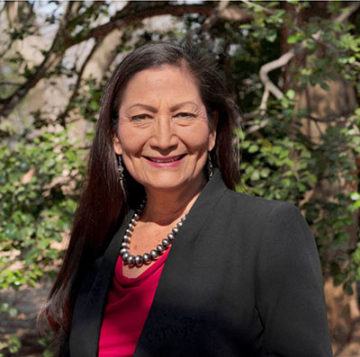by Mark Harvey
Three years ago while filling my truck with gas in western New Mexico on a cold fall evening, a young woman, barefoot and wearing nothing but a sundress, came up to me and asked if she could get a ride into the town of Gallup. Her bare feet and summer clothing in the biting air made me suspicious so I asked her a few questions. She told me she was traveling home to Taos after spending some time in the Pacific Northwest and that she had no money and had been hitchhiking for days. She was a little disheveled, startlingly beautiful, and her story didn’t make much sense. But she looked cold so I agreed to take her to Gallup, thinking I might be of some small help.
We got in my truck and started down the highway when she said, “Do you mind if we go back and get my boots?”
“What do you mean?” I asked.
“My boots, I left them on the road a little before the gas station.”
So we turned around and drove back a few hundred yards and sure enough, there was a pair of pink cowboy boots neatly placed on the side of the road. At that point—as if the signs weren’t strong enough already–I realized the woman might be suffering some psychological trauma and that her thinking was foggy. I asked her if she had some family to call in Taos, but she said she couldn’t get in touch with them.
I had just been shopping for groceries and the woman asked if she could have something to eat. I told her to eat anything she wanted from the bag. She devoured a bag of almonds and a couple of apples as if she hadn’t eaten for days. As we approached Gallup, I asked her again if there was someone she could call for help. She said there was no one and that she would be fine.
When we got to Gallup, she asked to be let out of the car. She pointed at my jacket and asked if she could take it. I gave it to her, still not knowing what to do or if there was a way to help. But she definitely wanted to be on her way. When she got out of my truck, I felt worried for the young woman clearly on the margins of everything. I don’t know what happened to her and I wonder if she ever made it to Taos or if, like so many women in rural America, she went missing.
Gallup is a town where the marks of missing and murdered Native American women are everywhere. On my visit, I noticed a lot of graffiti and murals about the missing with hashtags like #MMIW (Missing and Murdered Indigenous Women), #nomorestolensisters, and #amInext. I saw evocative, eerily beautiful murals in Gallup and its neighboring Arizona town, Fort Defiance, depicting indigenous women with a painted red handprint over their faces. The handprint, I’ve been told, can symbolize the lost voice of the victim and the lack of attention given to what is a continental menace.

Jamie Lynette Yazzie, a 32-year-old Navajo mother of three, was last seen on June 30, 2019, in the tiny town of Piñon, Arizona, on the Navajo Nation. Piñon sits about 120 miles to the northwest of Gallup at the junction of Indian Route 41 and Indian Route 4, two tertiary highways far from it all. Yazzie worked at the Piñon Health Clinic right up until the time she disappeared. She had worked at the clinic since 2010 as a medical assistant in the pediatric ward and was known to be reliable, so when she didn’t show up for work and didn’t answer texts and phone calls, her family became worried.
At first, they assumed she was just busy, so a few days went by before the family realized she was truly missing. They contacted the Navajo Police and the FBI and a search was organized. The tribal police, members of the FBI, and dozens of volunteers searched the area for two solid days. They searched around the clinic where Jamie worked and along Indian Route 4 as far as the border of the Hopi Nation. Jamie had told her sister that she had been having fights with her boyfriend, who also lived in Piñon. So they searched the area around his house and questioned him. They reportedly found no clues and according to family members, the case quickly went to the back burner.
According to Jamie’s sister Leona, Jamie was funny, loving, non-judgmental, and a person to go to if you were having a bad day—or even a bad life. “She was like our Mom growing up and I thought of her as my older sister even though she was my younger sister,” Leona says. “When you didn’t think your life was very meaningful, you could go to her because she wanted to make you feel better about yourself. And she wanted to do it in person. When I lived in Denver she would drive all day just to see us,” Leona says.
So even though the FBI and tribal police seemed to make no progress on the case, Jamie’s family and friends redoubled their efforts. Her mother, Ethelene, left her job at the local grocer to take care of Jamie’s children and to press the tribal police and FBI for reports on the case. Jamie’s aunt, Marilene, dedicated herself to working on publicity and social media. She makes regular posts on Facebook and her latest one on May 5 of this year reads, “Say her name, Jamie Yazzie, Jamie Yazzie. Please do not let her be forgotten!! She has 3 boys waiting for answers.” Marilene’s own partner and the father of her children had been murdered in 2005 on the Navajo Nation and she knows the frustrations of seeking justice.

The family raised reward money of $5,000 and with the help of a group called MMIW Medicine Wheel erected a huge billboard near Winslow, Arizona, on Interstate 40 with Jamie’s photo and the offer of a reward. Darlene Gomez, an attorney in Albuquerque, offered to work pro bono on the case. She put pressure on the FBI and the Navajo investigators to help continue the search. Perhaps because of the pressure from Gomez, the FBI added another $5,000 to the reward.
Finding a missing Native American woman is always difficult for several reasons. To begin, there are peculiar laws and conflicting jurisdictions between tribal police, the state, and the federal government. For instance, in some states, if a major crime such as rape or murder is committed on an Indian Nation by an Indian to an Indian, the jurisdiction is under the tribal police and the federal government. But if the crime is done by a non-Indian to an Indian, the jurisdiction comes entirely under the Federal Government. In other states such as Alaska and California, the role of the Federal government is largely diminished while the state’s power is vastly increased. In the same crime of rape or murder by a non-Indian upon an Indian, the jurisdiction falls entirely to the state.
The rule that prevents Native tribes from prosecuting non-Indians who commit crimes on Indian lands came out of a Supreme Court decision titled Oliphant v. Suquamish in 1978. The details of that case are beyond the scope of this article, but several people I spoke with, who are well versed on the subject, said that because tribal police do not have the power to arrest and prosecute non-Indians, Indian lands attract predatory rapists who know there is little chance of their being apprehended and brought to justice.
“Can you imagine having a missing family member and trying to navigate the three jurisdictions—tribal, state, and federal—with no help,” Gomez asks. “Families of missing women do better when they are represented by attorneys who understand the system but not everyone can afford an attorney.”
According to Gomez, both tribal investigators and federal investigators are severely underfunded. Given the vast size of some of the Indian Nations and the number of missing women, tribal, state, and federal agencies just don’t have the resources to properly investigate each case. The Navajo Nation is more than 17 million acres (about the size of West Virginia) and has only 210 commissioned police officers. It’s divided into seven districts and Piñon sits in the Chinle district, which is just about the center of the nation. Despite being 1.3 million acres in size and having a population of around 28,000 people, there are only two criminal investigators in the Chinle District. Having just two investigators to cover an area of that size defines understaffing and underfunding. Consequently it is a territory where many crimes go unsolved.
The number of missing and murdered indigenous women in both the United States and Canada is way out of proportion for that population. According to a 2008 report commissioned by the US Department of Justice, the murder rates among Native American women in some counties is more than 10 times the national average. Indigenous women in the United States go missing at roughly twice the rate of the national average.
In Canada, the numbers are similar. According to a national inquiry commissioned by the Royal Canadian Mounted Police, between 2001 and 2015, indigenous women in Canada were murdered at a rate of roughly six times higher than the rate for non-indigenous women.
Gomez also says that in general, the media doesn’t cover the cases of missing indigenous women as carefully or as intensely as they do that of missing white people. “I was hired by the family of a missing Anglo man and within two days we had stories in the media about his disappearance,” Gomez says. “But they don’t have an interest in missing indigenous women. Their attitude is ‘We don’t know them, we don’t see them, they’re not us.’“

One of the people working to help find Yazzie is Marki Davis, who lives in Layton, Utah. As a private investigator, Davis saw a need to support families of missing persons and formed a non-profit called We Help The Missing and assembled a group of private investigators and citizen volunteers to track down lost family members. She formed the organization out of a belief that they don’t get the attention they deserve. “When a person is missing, it’s worse than death,” she said in a telephone interview. “It’s the void of the unknown and your emotions run from guilt to panic to grief to remorse. You wonder if you could do more and you think about the last words you said or didn’t say.”
Davis says that the search for missing persons can go on for decades and even generations. “We have an old case from 1932 of a missing woman, and her grandchildren are looking now. It’s generational—it leaves a generational void. When you don’t know where they are, there’s no peace. You can’t find the peace you’d find at a grave,” she said.
Marilene James agrees that having a missing family member is worse than a death. “I lost my Dad in January but at least I know where he is,” she says. “When someone dies you can talk to them at their graveside. I don’t know where to talk to Jamie spiritually. I don’t know if she’s cold or starving or okay.”
While the woman I met who was traveling to Taos seemed to be in dire straits, most of the missing indigenous women are ordinary people going about their lives with the usual challenges of raising children, caring for elders, studying, and working. And while some law enforcement agencies—including some tribal police–blame abductions on the women themselves, citing drug and alcohol use, Indian women have some of the highest rates of abstinence from alcohol of any ethnicity, according to an extensive report in The Journal of Drug and Alcohol Dependence published in 2016. Through statistical analysis, the report discredits long-held myths about Native Americans and their abuse of alcohol relative to other ethnicities.
Marilene and Leona both have dreams about Jamie. In Marilene’s dreams, when she sees Jamie, she tries to take note of the surroundings, looking for clues. “Sometimes in the dream, Jamie will say ‘I’m okay, don’t waste your time looking for me.’ But she knows I’m stubborn and won’t listen and that I’m going to keep looking,” Marilene says.
Leona says she often dreams of Jamie passing through different houses. “When I see her in dreams, she is laughing sometimes,” Leona says. “Where have you been, I’ll ask her.”
There is some good news in this story, and that is the recent appointment of Deb Haaland, to the position of Secretary of the Interior. Haaland, a member of the Laguna Pueblo tribe of New Mexico, is the first Native American to serve as a cabinet secretary. One of Haaland’s first acts was to establish the Missing and Murdered Unit (MMU) within the Bureau of Indian Affairs. The MMU is meant to put the full force of the federal government behind solving cases of missing and murdered Indigenous people before they go cold. According to The Department of Interior, the task force will endeavor to coordinate the various federal agencies such as the FBI, the Department of Justice’s National Missing and Unidentified Persons System, and the US Marshals to work harder and more efficiently at solving the crimes.

But maybe what’s more important in all this is the very appointment of Haaland to Secretary of the Interior. Appointing a Native American woman to the cabinet position that controls more federal land than any other post—507 million acres—is profound and poetic. As secretary of the interior, Haaland oversees vast stretches of lands once inhabited entirely by Indians. She has more dominion over American land than any other person alive, save the president.
There is a vast distance between the abductions and summary executions of Native Women during America’s campaigns to eradicate Indians in past centuries and the formidable position that Haaland holds today.
There is a vast distance between the lonely and often hopeless cases of murdered and missing indigenous women and the optimism generated on tribal nations by Haaland’s appointment. Indian women can still be abducted, often with little consequence, on tribal lands or in major cities. It will take decades to cross that distance and this year and next year there will be more unsolved abductions and murders of Native women. But indigenous people are not standing still and refuse to be silenced. Thousands upon thousands of Native Americans from Alaska to Florida are writing, teaching, litigating, organizing, protesting, and speaking to reclaim what some lost hundreds of years ago and what some have lost today: personal sovereignty.
